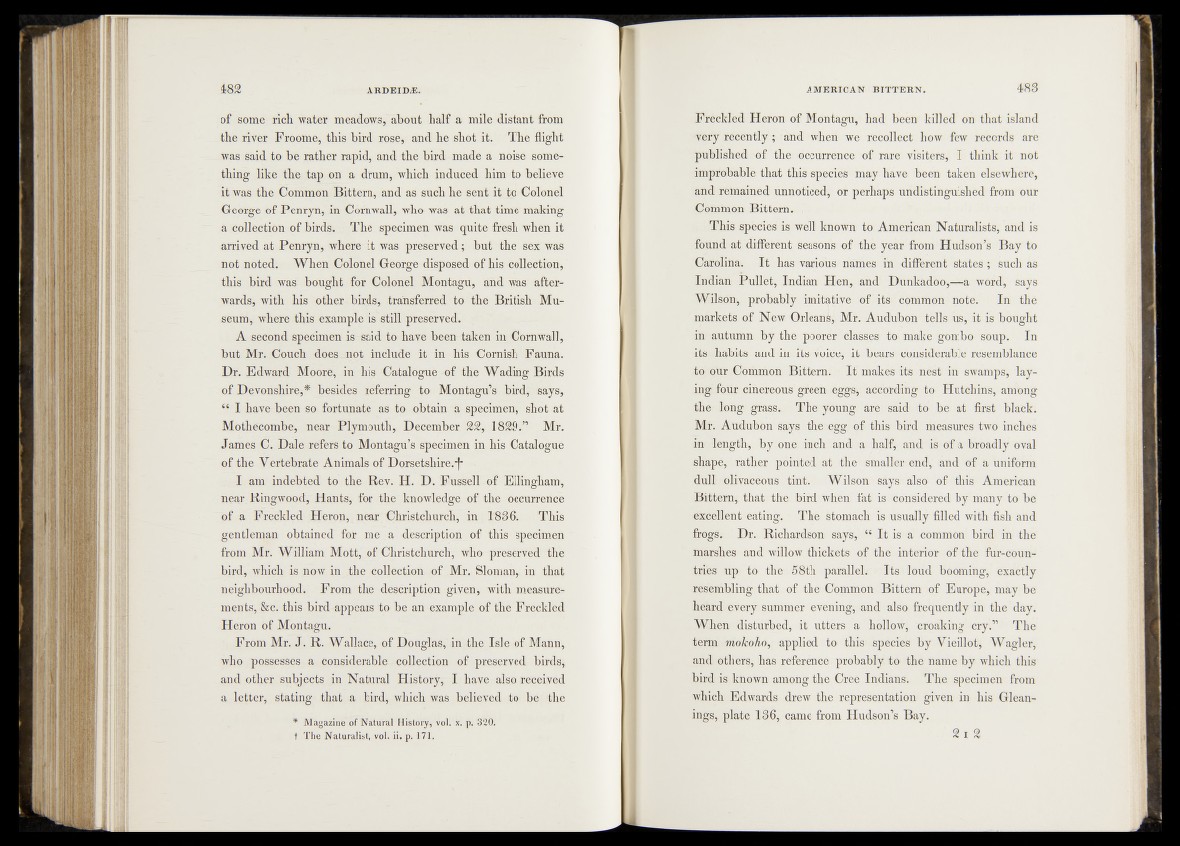
of some rich water meadows,“about half a mile distant from
the river Froome, this bird rose, and he shot it. The; flight
was said to be rather rapid-, and the bird-made a noise something
like the tap on a drum, which induced, him to believe
it was the Common Bittern, and as such he sent it to Colonel
George of Penryn, in Cornwall, who was at that time making
a collection of birds. The specimen was quite fresh when it
arrived at Penryn, where it was preserved; but the sex was
not noted; When Colonel George disposed of his collection,'
this bird was bought for Colonel Montagu, ahd was afterwards,
with his other- birds, transferred to the British Museum,
where this example is still preserved. ^
A second specimen issaid to have been-taken in Cornwall,
but Mr. Couch' doe&_not include it in his Cornish Fauna.
Dr. Edward Moore, in his Catalogue-of the Wading Birds
of Devonshire,* besides referring to Montagu’s bird; &ys,
“ I have been so fortunate as to obtain'a specimen, shot at
Mothecombe, near Plymouth, December , 22,. 1829.” Mr.
James C. Dale refers to Montagu’s specimen in his Catalogue
of the Vertebrate Animals of Dorsetshire.•ƒ* ■
| I am indebted to the Rev. H. D. Fussell ofs^lllngliam,
near. Ringwood, Hants, for the- knowledge of the occurrence
of a Freckled Heron, near Christchurch, in r<336. . .'This
gentlen|gjn obtainedT For me. a description of this* specimen
from Mr. William Mott," of Christchurch, who--preserved the
bird, which k now in the collection of Mr. Sloman, in that
neighbourhood. From the description given, with measurements,
&c. this bird-appears to be an example of the Freckled
Heron of Montagu.
• From Mr. J. R. Wallace, of Douglas, in the Isle of Mann,
who possesses a considerable -collection of preserved birds,
a n o th e r subjects Jn Natural History,- 1 haie alii; receded
a letter, stating that a bird, which was believed to be the
* Magazine of Natural History, vol. x. p. 320|-
f The Naturalist, vol. ii. p. 171.
Freckled Heron of Montagu, had been killed on that island
very recently ; and when we recollect how few records are
published of the occurrence of rare visiters, I think it not
improbable that this species may have been taken elsewhere,
and remained unnoticed, or perhaps undistinguished from our
Common Bittern. ,
This species is well known to American Naturalists, and is
found at different seasons of the year from Hudson’s Bay to
Carolina. It has various names in different states ; such as
Indian Pullet, Indian Hen, and DunkadoOj-^-a word, says
Wilso% probably imitative: of its common note. In thé
markets of New Orleani, Mr. Audubon tells us, it is bought
in autumn by the poorer classes to make gombo soup. In
its habits and in its voice, it bears considerable resemblance
to;pur Common. Bittern. I t makes its nést in swamps, laying'four
cinereous'green eggs, according to Hutchins, among
the*'Jóng grass. Thé yóung are said to be at first black.
Mr. Audubon Says the;eggs of this bird measures two inches
in length,, by one* inch and a half,, and is of a broadly oval
shape, rather pointed at the'’-smaller end-, and of à uniform
dull olivaceous tint.- Wilson says also" of this American
Bittern, that the bird when: fat is considered by many to be
excell en t. eating. The stomach is usually filled with fish and
frogs. Dr. Richardson says,- “ I t is a common bird in the
marshes and willow thickets of the interior?of the fur-countries
up to the 58lh parallel/ Its loud booming, exactly
resembling that of the Common Bittern of Europe, may be
heard every summer evening, and also frequently in the day.
When disturbed, it utters a hollow, croaking cry.” The
term molcoho, applied to this species by Vieillot, Wagler,
and« others, has reference probably to the name by which this
bird is known among the Cree Indians. The specimen from
which Edwards drew the representation given in his Gleanings,
plate 186, came from Hudson’s Bay.
2 i 2